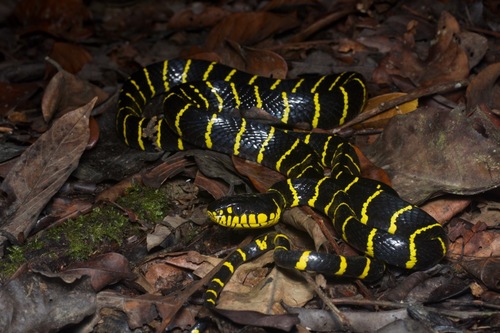
Mangrove Snake
Boiga dendrophila, the mangrove snake, dazzles with black and yellow bands. Residing in Southeast Asia's mangroves, this semi-venomous, nocturnal predator excels in climbing. Its agile movements and potent venom make it a formidable hunter, vital for maintaining ecological balance.
12-17 years
Lifespan
Length: 1.829 - 2.134 m
Size
Medium
Aggression
Least Concern
Conservation Status
Stable
Population Trend
Characteristics
Boiga dendrophila, commonly known as the mangrove snake, is a strikingly beautiful serpent with glossy black scales adorned with vibrant yellow bands. This arboreal species thrives in Southeast Asian mangrove forests and coastal lowlands. Noted for its semi-venomous nature, it preys on birds and small mammals, employing its potent venom to subdue prey. Though primarily nocturnal, it may be seen basking during the day. Its long, slender body and prehensile tail make it an adept climber, perfectly adapted to its arboreal lifestyle.
Distribution Range of the Mangrove Snake
Boiga dendrophila, commonly known as the mangrove snake or gold-ringed cat snake, is native to Southeast Asia. Its geographical distribution includes the countries of Brunei, Indonesia, Malaysia, Myanmar, the Philippines, Singapore, Thailand, and Vietnam.
Mangrove Snake's Habitat
Environmental Conditions
The mangrove snake typically inhabits tropical lowland rainforests, mangrove swamps, and other forested areas near water bodies. It thrives in humid conditions with high temperatures, which are characteristic of its native tropical climate.
Ecological Niche
Boiga dendrophila is primarily arboreal, spending much of its time in trees. It is nocturnal and carnivorous, preying on birds, lizards, and small mammals. Its adaptations to an arboreal lifestyle include a slender body that aids in navigating through the branches and a prehensile tail for gripping. The snake's habitat preference for mangrove areas and dense forests allows it to utilize the cover and resources these environments provide.
Copyright @ Nature Style Limited. All Rights Reserved.
 English
English